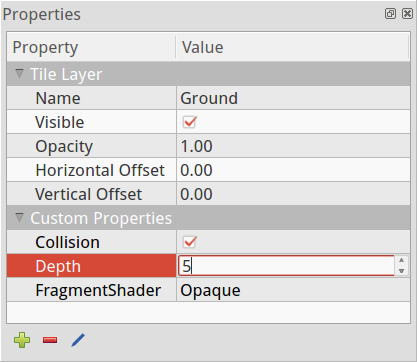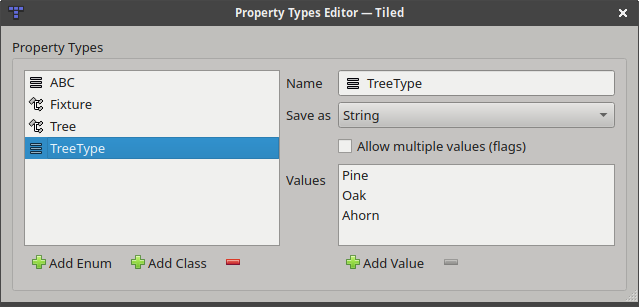Custom Properties
One of the major strengths of Tiled is that it allows setting custom properties on all of its basic data structures. This way it is possible to include many forms of custom information, which can later be used by your game or by the framework you’re using to integrate Tiled maps.
Custom properties are displayed in the Properties view. This view is context-sensitive, usually displaying the properties of the last selected object. It also supports multi-selection, for changing the properties of many objects at once.

Properties View
Adding Properties
When you add a property (using the ‘+’ button at the bottom of the Properties view), you are prompted for its name and its type. Tiled supports the following basic property types:
bool (true or false)
color (a 32-bit color value)
file (a relative path referencing a file)
float (a floating point number)
int (a whole number)
object (a reference to an object) - Since Tiled 1.4
string (any text, including multi-line text)

Add Property Dialog
The property type is used to choose a custom editor in the Properties view. Choosing a number or boolean type also avoids that the value will get quoted in JSON and Lua exports.
The context menu for custom file properties provides a quick way to open the file in its preferred editor. For object references, there is an action to quickly jump to the referenced object.
Custom Types
In addition to the basic property types listed above, you can define custom types in your project. Tiled supports custom enums and custom classes.

Custom Types Editor
Note
These types are automatically saved in the project file. Hence you need to create a project, before you can set up your custom types.
Custom Enums
An enum is useful if you want to limit the options for a certain property to a fixed set of values.
An enum also defines how its value is saved. It can be saved as a string, saving one of its values directly. Alternatively it can be saved as a number, the index of the current value in the list of values. The former is more readable whereas the latter could easier and more efficient to load.
Finally, an enum can also allow multiple values to be chosen. In this case each option is displayed with a checkbox. When saving as string, a comma-separated list is used and when saving as number the selected indexes are encoded as bitflags. In both cases, the maximum number of flags supported is 31, since internally a 32-bit signed integer is used to store the value.
Custom Classes
A class is useful if you want to be able to add a set of properties at once, with predefined defaults. It can also prevent excessive prefixing of property names. Classes can have members referring to other classes.
Each data type has a “Class” property, which can be used to refer to a custom class. The members of this class will then be directly available as custom properties of that instance (before Tiled 1.9, this feature was only available for objects and tiles as the “Type” property).
Each class can also have a custom color, which is used to make objects more recognizable. The class color is used when rendering shape objects, object name labels and connections between objects.
In the JSON and Lua file formats, custom class properties used as property values are saved using the native object and table constructs.
Tile Property Inheritance
When custom properties are added to a tile, these properties will also be visible when an object instance of that tile is selected. This enables easy per-object overriding of certain default properties associated with a tile. This becomes especially useful when combined with Typed Tiles.
Inherited properties will be displayed in gray (disabled text color), whereas overridden properties will be displayed in black (usual text color).
Typed Tiles
If you’re using tile objects, you can set the class on the tile to avoid having to set it on each object instance. Setting the class on the tile makes the predefined properties visible when having the tile selected, allowing to override the values. It also makes those possibly overridden values visible when having a tile object instance selected, again allowing you to override them.
An example use-case for this would be to define custom classes like “NPC”, “Enemy” or “Item” with properties like “name”, “health” or “weight”. You can then specify values for these on the tiles representing these entities. And when placing those tiles as objects, you can override those values if you need to.